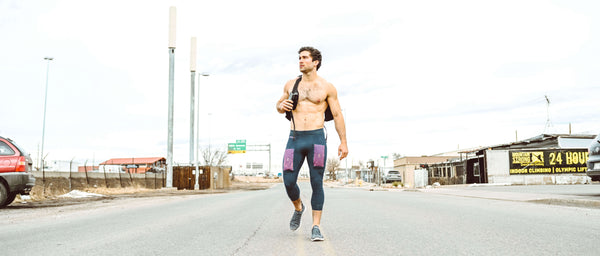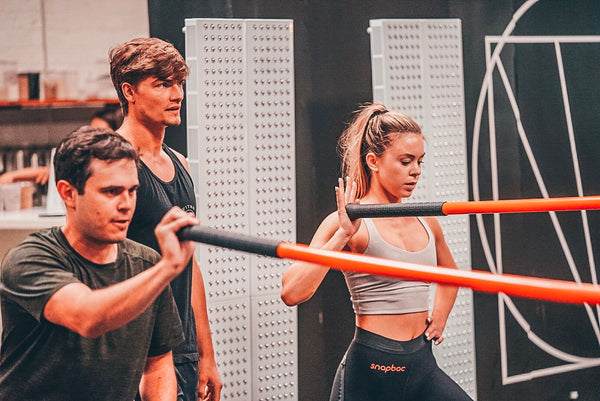Overview
If you’ve ever felt the twinge in the lower back or the sharp pain as you dive for the ball, you know the immediate dread that is felt by every athlete. Back pain can be quite common when you stay active and use your body in repetitive or jarring ways. We’ve taken a closer look at the standard injuries sustained by athletes and fitness centered individuals and researched ways to help you support and exercise your back to reduce your chances of severe damage. It’s important to understand the pain you feel, know what to do and not do if it happens to you, and what back exercises you can incorporate to lower your risk.
10 At-Home Back Exercises to Prevent Pain
For a professional athlete or a weekend warrior, back pain is a common problem that can bring your activity levels to a screeching halt. It’s not just the physically active that suffer from back problems. According to the American Physical Therapy Association, nearly two-thirds of the US experience regular lumbar discomfort, and at times it may not even be our sport that is the problem. It can be the small daily things that can cause the biggest issues, and how we react can either make it better or worse.
When we feel that twinge, our first reaction may be to rest the back, perhaps lay around for a day or two to let it heal before the next marathon, football game, or soccer scrimmage, but this will only increase the pain. It may be counterintuitive, but back pain can actually get worse with rest. It needs gentle movement. When you use your back muscles, they warm up, stretch out, and stay loose instead of cramping and pinching causing further damage.
We want to take a look at several types of back pain most often experienced by athletes, what to do when you experience that pain, and several exercise do’s and don’ts to prevent pain, relieve pain, and strengthen your core.
Common Back Pains and Injuries for Athletes
When you devote your body to a sport, it will take more wear and tear than the standard desk job. You may have a stronger core and less risk for posture-based injuries than the daily office worker, but you have greater risk of chronic and acute back injuries particularly to your lumbar, or lower back. Depending on the sport you play, you may be sustaining many blows or tackles that can increase the chances of stress and injury to the spine and muscles. There is increased impact, pressure, twists, turns, jerky reactions, and movement in general if you are involved in any sport, be it golf, tennis, ice skating or football, hockey, and Ironman marathons. The pain you feel may be from a particular impact or trauma that you can pinpoint, or it may be from a constant and repetitive movement or pose that is causing microtraumas and tears, like a catcher staying crouched or hunched.
Sprains and Strains
The most common reason an athlete feels pain in their back is from a sprain or a strain. If you have a sprain, it’s because you’ve pulled the ligaments that hold your spine in place too hard and too fast causing them to overstretch. If you are experiencing a strain, you’ve actually torn muscle tissue. These are quite common from forceful, repetitive motions, like too many golf swings, or improper form and technique in the case of lifts, weights or posture on the field. Consider a tackle. If your head is down, you are going to create a greater impact and a greater risk of cervical spine damage, not to mention a penalty and possible concussion. You want to make contact with your shoulder and keep your neck extended and up without making contact with your face mask. It’s important to know the correct posture for your sport and for your position.
Spasms
The next common back pain comes from using muscles that are typically at rest. This can cause back spasms. When muscles are rarely used and then thrown into overuse, even in an instant, they can seize up in an involuntary contraction.
Vertebral Compression Fracture
Athletes must see a doctor when they feel severe back pain to rule out a vertebral compression fracture. This will be caused by an event you will remember - a specific tackle, blow, fall, or hit that caused enough force to compress one of the individual blocks of your spine.
Though contact sports such as football carry some of the greatest risks of spinal injury and back pain, any physical activity can have an impact. Gymnasts often experience strains and sprains, and if they fall, they can even fracture a vertebra. Tennis can put an incredible amount of stress and torque on the spine from powerful swings. Soccer, hockey, rugby, and lacrosse all have high impact risks.
What to Do If You Hurt Your Back
If you strain a muscle or sprain a ligament in your neck, upper back and shoulders, or lower back, you will feel pain and experience a limited range of motion. The moment you feel this pain, you need to apply ice immediately. This will start the healing process and reduce the pain and swelling. You want to reduce the swelling and possible edema quickly so the damaged muscle can repair itself, so apply compression bandages or Snapbac’s compression system.
Directly after the trauma, you do want to rest for the day and depending on the injury you may need a little longer. The important thing to remember is how the pain felt at the beginning because once the initial, intense pain subsides, that’s when you don’t want to rest any longer. This is when you need limited activities and gentle stretching to quicken the healing of the muscle by increasing the blood flow to the tissue
As the pain becomes less, add strengthening exercises to your stretches. This does not mean heavy weight lifting. Refer to the back workout exercises below. During this time, you can be alternating heat therapy with the cold packs to ease any residual pain and keep the blood circulating in the area. If you feel it is necessary, you can talk to your doctor about pain medications, and you may also find relief from light massage.
What NOT to Do If You Hurt Your Back
As an athlete, you’re accustomed to working hard and feeling discomfort in your body, but when it comes to back pain, it’s important to not try and work through the pain. This can make things much worse. When doing exercises during back recovery, avoid lifting heavy weights or objects and do not do any overhead lifts like shoulder presses, as these apply pressure to the spinal discs and can stress the back. It is better to avoid leg presses which can stress your back due to the position on the machine and weighted squats. You also need to avoid any high-impact activities like running, jumping, aerobics, etc. For the female athletes, don’t wear high-heels until the pain has subsided.
The Best Back Workout Routine to Prevent Back Pain
Weak or imbalanced muscles in the back and abdominals make an athlete prone to more frequent back pain and injuries. You want to focus on moves that improve your spinal stability and muscle strength. It is crucial to begin all exercise with a proper warm-up and end with a cool-down to further protect your back. Stretch out your muscles slowly, without bouncing and stop at any point if you feel pain.
-
Lower Abdominal Strength
This move may seem too easy, but it is effective. When the abdomen is weak, the lower back is at risk and can tighten up, so it’s just as important to strengthen your front core as it is your back. Lay on your back, hands flat against the floor with your knees bent, hip-width apart. Coordinate the movement with your breathing to create space and expansion. On the inhale, bring one knee up and into your chest as far as you can without using your hands or leg muscles. You want to feel this in your lower abs. As you exhale, lower your foot back to the ground, and alternate legs on the next inhale. Depending on your current strength, you want to perform 8 – 10 reps on each leg or until you feel a slight burn or tremble in the lower stomach.
![]()
-
Balancing Table Pose
Yoga is one of the greatest sources of movements to balance and strengthen the core, back and spine. Start in table top position, on all fours, knees hip-width apart, hands below the shoulders with your back flat and neck extended straight as you look at the ground. Pull your stomach in activating your core and supporting your back so it does not sag. Gently raise and extend one leg out behind you keeping your hips flat and parallel to the floor, and then slowly raise and extend the opposite arm out in front of you. You want to hold the pose for 10 – 15 seconds and then slowly lower your arm and leg and switch to the opposite sides. Try to do 6 – 8 reps on each side.
![]()
-
The Pull-Up
Another basic move yet incredibly challenging is the pull-up. All you need is access to a bar that will support your weight, and you are ready to begin. Reach up and grab the bar with your palms facing out and let your body freely hang. For some, you may need to work up to this move, but the goal is to pull your body up and get your head over the bar without overextending your neck. You want to keep a straight spine and let the movement come from your elbows. You can cross your ankles and bend your knees at a 90-degree angle. Work up as many repetitions as you can.
![]()
-
The Many Forms of Plank
This is another move from standard yoga practice that is essential for proper spine health. Begin by laying on the floor, face down. Then press up into a push-up with your hands directly below your shoulders, and hold at the top, arms fully extended, hips in line with the spine and back flat. Keep your neck extended, face down. Pull your stomach in to support the lower back. You do not want your hips up in the air. Keep a straight line from your ankles to the crown of your head. Hold this position for 15 – 20 seconds or until you feel the heat and tremble in the body.
Next, drop your forearms to the ground with your elbows directly below your shoulders and hands in front of you with your fingers forward and in line with your elbows. Keep the same form as above and hold.
![]()
-
The Side Plank
Lay on your side with your feet stacked on top of each other, toes pointing forward. Now push up with your arm that is on the ground raising your body up into a balanced posed. The arm on top will raise into the air inline with your shoulders and the arm extended to the ground. For your supporting arm, be sure that it is slightly out in front of your shoulder and your weight is not sitting on your wrist. Keep your neck, spine and hips in a straight line. Do not let your hips sink towards the ground.
![]()
-
The Bridge
Lay on your back with your knees bent, feet flat on the floor, hip-width apart and arms down at your sides. Push up with your hips, quads and lower back to raise your hips into the air creating a straight line from your knees to your shoulders which rest squarely on the ground. Hold at the top for 2 – 3 seconds, then lower back down and repeat. Do this 10 – 15 times.
![]()
-
Go for a Swim
This one may be a bit more complicated if you are not near a pool, but water provides an incredibly gentle resistance while still being supportive, and swimming is the ultimate core and spine strengthener. When back problems limit your aerobic options, swimming laps could be the answer.
![]()
-
Cat & Cow
Yet another yoga pose, switching between Cat and Cow is great for gently stretching the spine and creating micromovements. Get on all fours in the tabletop position from above, knees hip-width apart, hands below the shoulders with your back flat and neck extended straight as you look at the ground. On an inhale, pull your abdomen in and curl your spine up into the air, tucking your chin into your chest feeling a gentle space between each vertebra. Then on your exhale drop your abdomen, curving the spine in and down while raising your chin up. This should be a full release.
![]()
-
Child’s Pose
This is an excellent stretch to do several times a day including after a workout. Start on all fours and drop your glutes to your feet, lowering your chest to the ground and stretching your arms out in front of you. Let your head rest on the floor or stack your fists and place them under your forehead. You can spread your knees out to create more abdominal space but try to keep your glutes touching your heels.
![]()
-
Stretch, Stretch, Stretch
It is incredibly important to keep the back loose and stretched. Lay flat on the floor and slowly pull one knee into your chest while the opposite leg is extended. Then switch.
Pull both knees into the chest and send them to the right while your head and opposite arm extend to the left, keeping your shoulders flat on the ground.
Raise one leg straight up into the air while the other stays flat on the ground and your hands support behind the knee. You can use a band or towel around the top of your foot to stabilize this move.
![]()













